Nursing Management: Strategies for Conflict Resolution in ICU Setting
VerifiedAdded on 2023/06/11
|12
|4543
|230
Report
AI Summary
This report delves into a conflict observed within an Intensive Care Unit (ICU) setting, highlighting the critical impact on patient care delivery. The scenario involves a disagreement between a physician and a nurse manager regarding a patient's treatment, specifically catheterization and medication administration. Contributing factors to the conflict include poor communication, differing professional opinions, and ineffective leadership styles. The analysis examines the consequences of the conflict on patients, nurses, and the healthcare organization, emphasizing delayed treatment decisions and decreased staff satisfaction. A root cause analysis identifies the underlying issues, leading to the proposal of conflict resolution strategies aimed at improving teamwork, communication, and patient outcomes. The report concludes by stressing the importance of proactive conflict management in healthcare settings to ensure optimal patient care and a positive work environment.
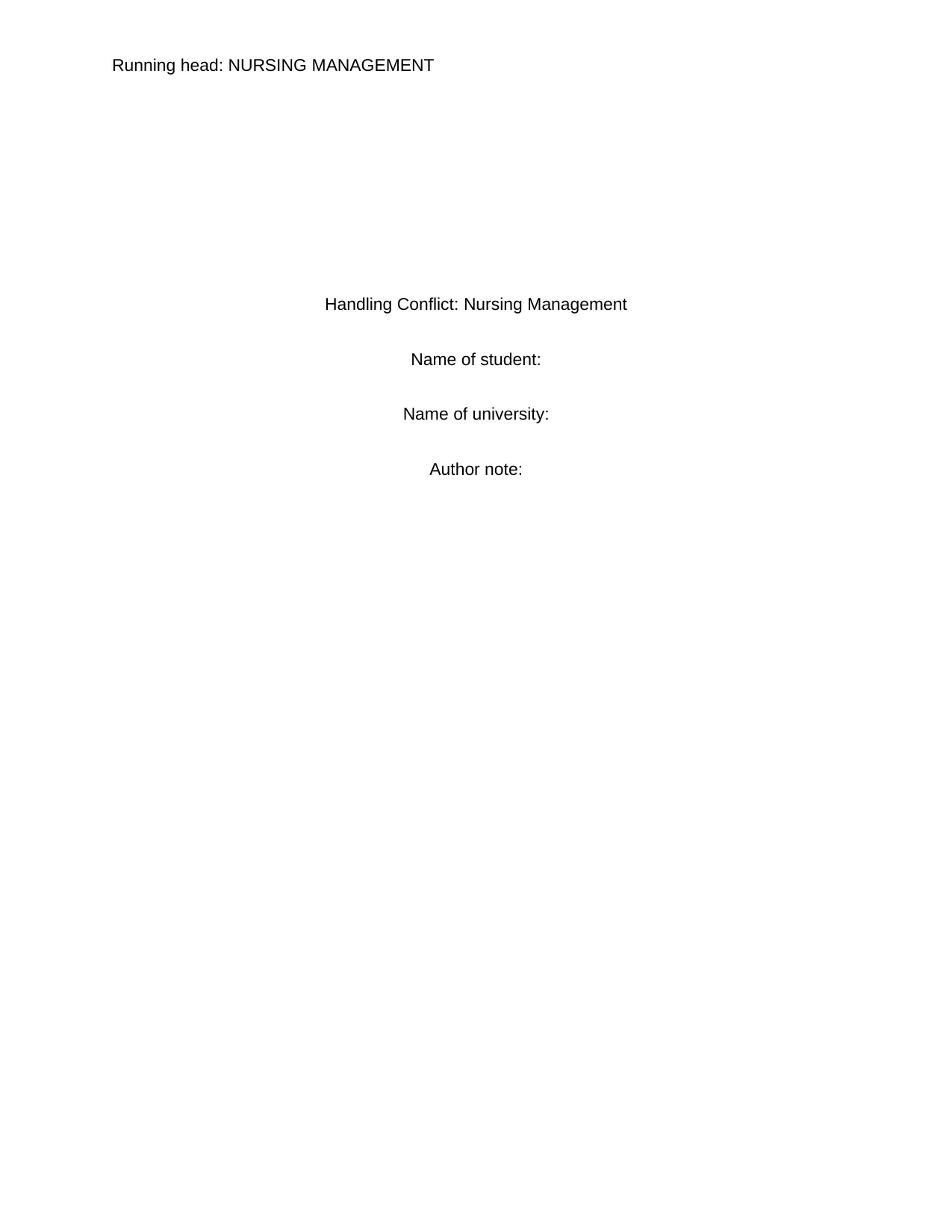
Running head: NURSING MANAGEMENT
Handling Conflict: Nursing Management
Name of student:
Name of university:
Author note:
Handling Conflict: Nursing Management
Name of student:
Name of university:
Author note:
Paraphrase This Document
Need a fresh take? Get an instant paraphrase of this document with our AI Paraphraser
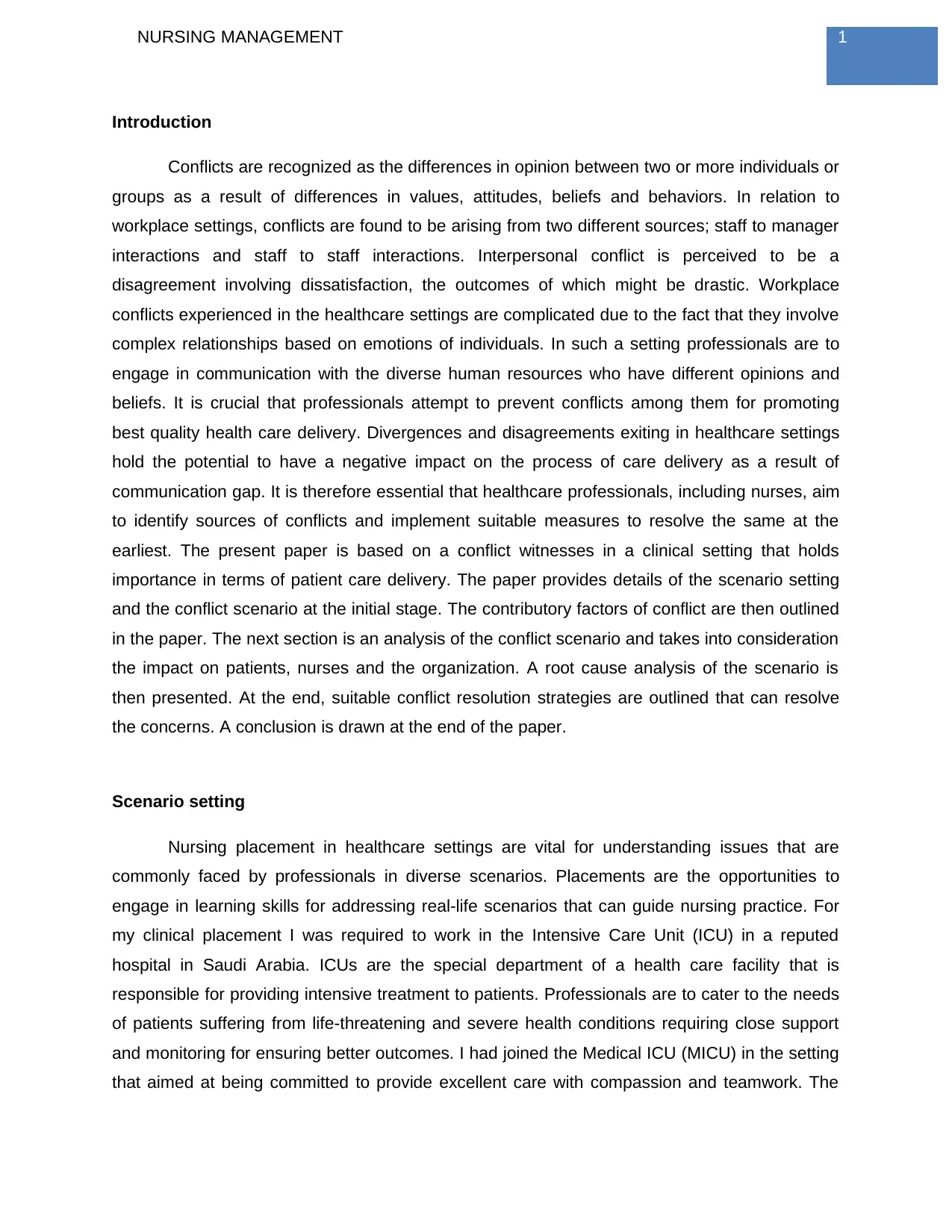
1NURSING MANAGEMENT
Introduction
Conflicts are recognized as the differences in opinion between two or more individuals or
groups as a result of differences in values, attitudes, beliefs and behaviors. In relation to
workplace settings, conflicts are found to be arising from two different sources; staff to manager
interactions and staff to staff interactions. Interpersonal conflict is perceived to be a
disagreement involving dissatisfaction, the outcomes of which might be drastic. Workplace
conflicts experienced in the healthcare settings are complicated due to the fact that they involve
complex relationships based on emotions of individuals. In such a setting professionals are to
engage in communication with the diverse human resources who have different opinions and
beliefs. It is crucial that professionals attempt to prevent conflicts among them for promoting
best quality health care delivery. Divergences and disagreements exiting in healthcare settings
hold the potential to have a negative impact on the process of care delivery as a result of
communication gap. It is therefore essential that healthcare professionals, including nurses, aim
to identify sources of conflicts and implement suitable measures to resolve the same at the
earliest. The present paper is based on a conflict witnesses in a clinical setting that holds
importance in terms of patient care delivery. The paper provides details of the scenario setting
and the conflict scenario at the initial stage. The contributory factors of conflict are then outlined
in the paper. The next section is an analysis of the conflict scenario and takes into consideration
the impact on patients, nurses and the organization. A root cause analysis of the scenario is
then presented. At the end, suitable conflict resolution strategies are outlined that can resolve
the concerns. A conclusion is drawn at the end of the paper.
Scenario setting
Nursing placement in healthcare settings are vital for understanding issues that are
commonly faced by professionals in diverse scenarios. Placements are the opportunities to
engage in learning skills for addressing real-life scenarios that can guide nursing practice. For
my clinical placement I was required to work in the Intensive Care Unit (ICU) in a reputed
hospital in Saudi Arabia. ICUs are the special department of a health care facility that is
responsible for providing intensive treatment to patients. Professionals are to cater to the needs
of patients suffering from life-threatening and severe health conditions requiring close support
and monitoring for ensuring better outcomes. I had joined the Medical ICU (MICU) in the setting
that aimed at being committed to provide excellent care with compassion and teamwork. The
Introduction
Conflicts are recognized as the differences in opinion between two or more individuals or
groups as a result of differences in values, attitudes, beliefs and behaviors. In relation to
workplace settings, conflicts are found to be arising from two different sources; staff to manager
interactions and staff to staff interactions. Interpersonal conflict is perceived to be a
disagreement involving dissatisfaction, the outcomes of which might be drastic. Workplace
conflicts experienced in the healthcare settings are complicated due to the fact that they involve
complex relationships based on emotions of individuals. In such a setting professionals are to
engage in communication with the diverse human resources who have different opinions and
beliefs. It is crucial that professionals attempt to prevent conflicts among them for promoting
best quality health care delivery. Divergences and disagreements exiting in healthcare settings
hold the potential to have a negative impact on the process of care delivery as a result of
communication gap. It is therefore essential that healthcare professionals, including nurses, aim
to identify sources of conflicts and implement suitable measures to resolve the same at the
earliest. The present paper is based on a conflict witnesses in a clinical setting that holds
importance in terms of patient care delivery. The paper provides details of the scenario setting
and the conflict scenario at the initial stage. The contributory factors of conflict are then outlined
in the paper. The next section is an analysis of the conflict scenario and takes into consideration
the impact on patients, nurses and the organization. A root cause analysis of the scenario is
then presented. At the end, suitable conflict resolution strategies are outlined that can resolve
the concerns. A conclusion is drawn at the end of the paper.
Scenario setting
Nursing placement in healthcare settings are vital for understanding issues that are
commonly faced by professionals in diverse scenarios. Placements are the opportunities to
engage in learning skills for addressing real-life scenarios that can guide nursing practice. For
my clinical placement I was required to work in the Intensive Care Unit (ICU) in a reputed
hospital in Saudi Arabia. ICUs are the special department of a health care facility that is
responsible for providing intensive treatment to patients. Professionals are to cater to the needs
of patients suffering from life-threatening and severe health conditions requiring close support
and monitoring for ensuring better outcomes. I had joined the Medical ICU (MICU) in the setting
that aimed at being committed to provide excellent care with compassion and teamwork. The
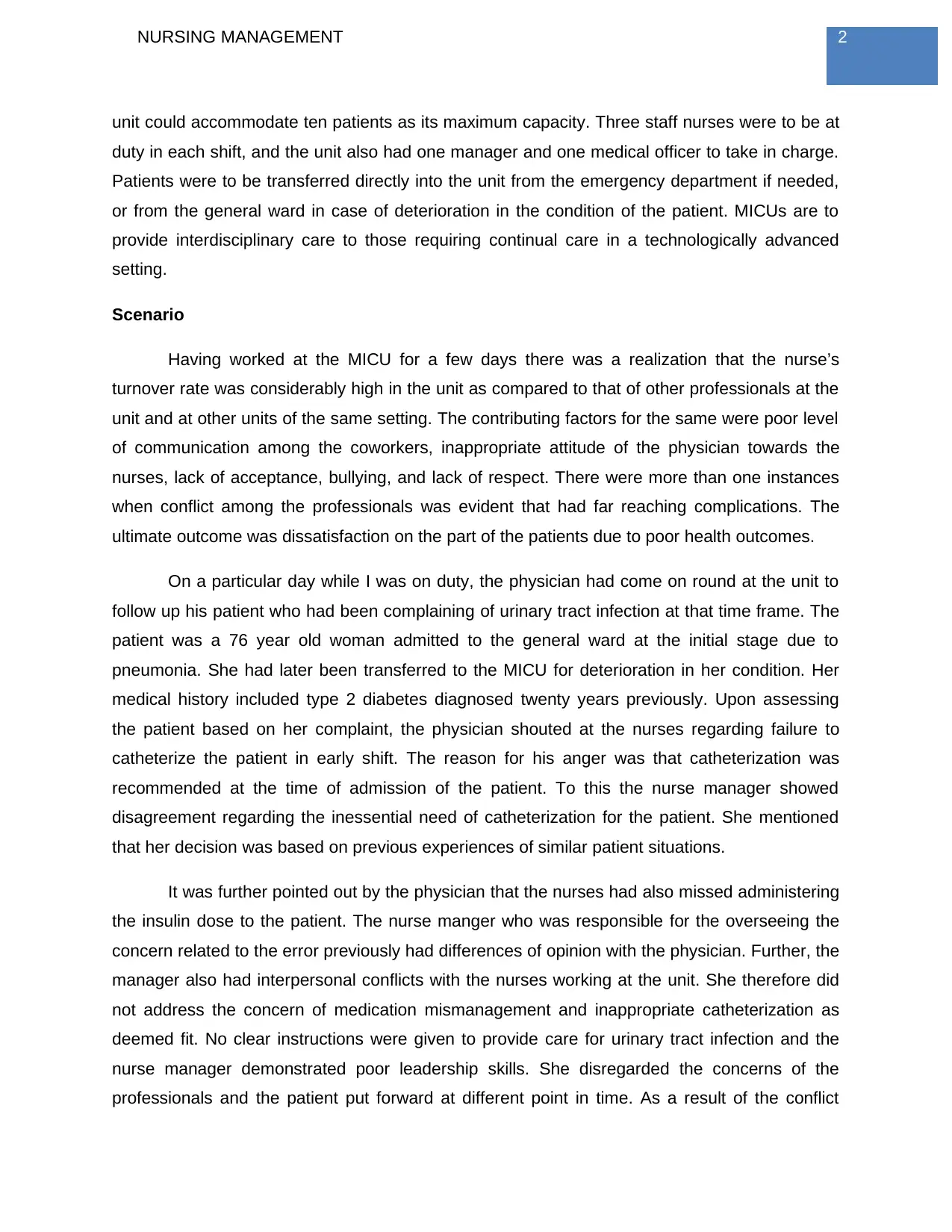
2NURSING MANAGEMENT
unit could accommodate ten patients as its maximum capacity. Three staff nurses were to be at
duty in each shift, and the unit also had one manager and one medical officer to take in charge.
Patients were to be transferred directly into the unit from the emergency department if needed,
or from the general ward in case of deterioration in the condition of the patient. MICUs are to
provide interdisciplinary care to those requiring continual care in a technologically advanced
setting.
Scenario
Having worked at the MICU for a few days there was a realization that the nurse’s
turnover rate was considerably high in the unit as compared to that of other professionals at the
unit and at other units of the same setting. The contributing factors for the same were poor level
of communication among the coworkers, inappropriate attitude of the physician towards the
nurses, lack of acceptance, bullying, and lack of respect. There were more than one instances
when conflict among the professionals was evident that had far reaching complications. The
ultimate outcome was dissatisfaction on the part of the patients due to poor health outcomes.
On a particular day while I was on duty, the physician had come on round at the unit to
follow up his patient who had been complaining of urinary tract infection at that time frame. The
patient was a 76 year old woman admitted to the general ward at the initial stage due to
pneumonia. She had later been transferred to the MICU for deterioration in her condition. Her
medical history included type 2 diabetes diagnosed twenty years previously. Upon assessing
the patient based on her complaint, the physician shouted at the nurses regarding failure to
catheterize the patient in early shift. The reason for his anger was that catheterization was
recommended at the time of admission of the patient. To this the nurse manager showed
disagreement regarding the inessential need of catheterization for the patient. She mentioned
that her decision was based on previous experiences of similar patient situations.
It was further pointed out by the physician that the nurses had also missed administering
the insulin dose to the patient. The nurse manger who was responsible for the overseeing the
concern related to the error previously had differences of opinion with the physician. Further, the
manager also had interpersonal conflicts with the nurses working at the unit. She therefore did
not address the concern of medication mismanagement and inappropriate catheterization as
deemed fit. No clear instructions were given to provide care for urinary tract infection and the
nurse manager demonstrated poor leadership skills. She disregarded the concerns of the
professionals and the patient put forward at different point in time. As a result of the conflict
unit could accommodate ten patients as its maximum capacity. Three staff nurses were to be at
duty in each shift, and the unit also had one manager and one medical officer to take in charge.
Patients were to be transferred directly into the unit from the emergency department if needed,
or from the general ward in case of deterioration in the condition of the patient. MICUs are to
provide interdisciplinary care to those requiring continual care in a technologically advanced
setting.
Scenario
Having worked at the MICU for a few days there was a realization that the nurse’s
turnover rate was considerably high in the unit as compared to that of other professionals at the
unit and at other units of the same setting. The contributing factors for the same were poor level
of communication among the coworkers, inappropriate attitude of the physician towards the
nurses, lack of acceptance, bullying, and lack of respect. There were more than one instances
when conflict among the professionals was evident that had far reaching complications. The
ultimate outcome was dissatisfaction on the part of the patients due to poor health outcomes.
On a particular day while I was on duty, the physician had come on round at the unit to
follow up his patient who had been complaining of urinary tract infection at that time frame. The
patient was a 76 year old woman admitted to the general ward at the initial stage due to
pneumonia. She had later been transferred to the MICU for deterioration in her condition. Her
medical history included type 2 diabetes diagnosed twenty years previously. Upon assessing
the patient based on her complaint, the physician shouted at the nurses regarding failure to
catheterize the patient in early shift. The reason for his anger was that catheterization was
recommended at the time of admission of the patient. To this the nurse manager showed
disagreement regarding the inessential need of catheterization for the patient. She mentioned
that her decision was based on previous experiences of similar patient situations.
It was further pointed out by the physician that the nurses had also missed administering
the insulin dose to the patient. The nurse manger who was responsible for the overseeing the
concern related to the error previously had differences of opinion with the physician. Further, the
manager also had interpersonal conflicts with the nurses working at the unit. She therefore did
not address the concern of medication mismanagement and inappropriate catheterization as
deemed fit. No clear instructions were given to provide care for urinary tract infection and the
nurse manager demonstrated poor leadership skills. She disregarded the concerns of the
professionals and the patient put forward at different point in time. As a result of the conflict
⊘ This is a preview!⊘
Do you want full access?
Subscribe today to unlock all pages.

Trusted by 1+ million students worldwide
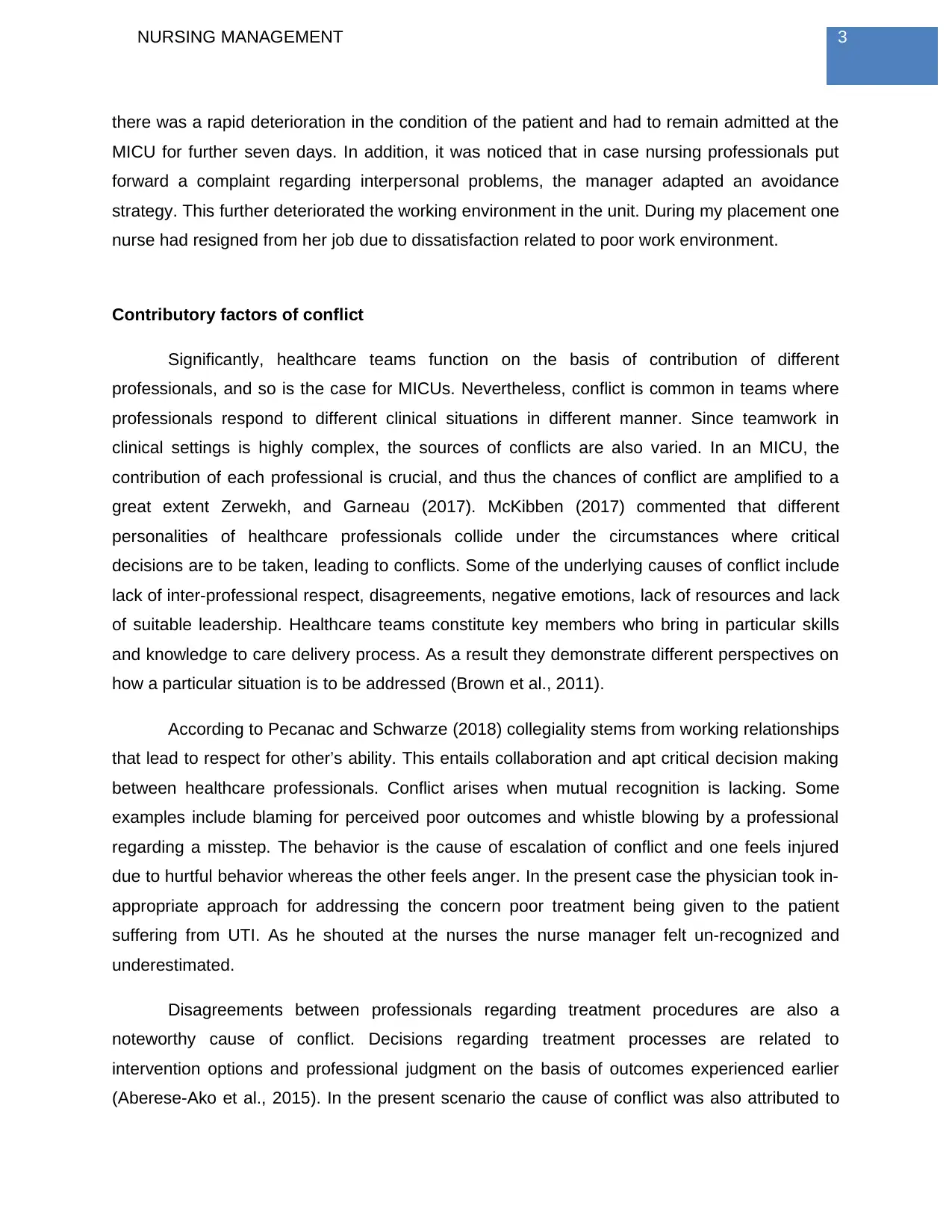
3NURSING MANAGEMENT
there was a rapid deterioration in the condition of the patient and had to remain admitted at the
MICU for further seven days. In addition, it was noticed that in case nursing professionals put
forward a complaint regarding interpersonal problems, the manager adapted an avoidance
strategy. This further deteriorated the working environment in the unit. During my placement one
nurse had resigned from her job due to dissatisfaction related to poor work environment.
Contributory factors of conflict
Significantly, healthcare teams function on the basis of contribution of different
professionals, and so is the case for MICUs. Nevertheless, conflict is common in teams where
professionals respond to different clinical situations in different manner. Since teamwork in
clinical settings is highly complex, the sources of conflicts are also varied. In an MICU, the
contribution of each professional is crucial, and thus the chances of conflict are amplified to a
great extent Zerwekh, and Garneau (2017). McKibben (2017) commented that different
personalities of healthcare professionals collide under the circumstances where critical
decisions are to be taken, leading to conflicts. Some of the underlying causes of conflict include
lack of inter-professional respect, disagreements, negative emotions, lack of resources and lack
of suitable leadership. Healthcare teams constitute key members who bring in particular skills
and knowledge to care delivery process. As a result they demonstrate different perspectives on
how a particular situation is to be addressed (Brown et al., 2011).
According to Pecanac and Schwarze (2018) collegiality stems from working relationships
that lead to respect for other’s ability. This entails collaboration and apt critical decision making
between healthcare professionals. Conflict arises when mutual recognition is lacking. Some
examples include blaming for perceived poor outcomes and whistle blowing by a professional
regarding a misstep. The behavior is the cause of escalation of conflict and one feels injured
due to hurtful behavior whereas the other feels anger. In the present case the physician took in-
appropriate approach for addressing the concern poor treatment being given to the patient
suffering from UTI. As he shouted at the nurses the nurse manager felt un-recognized and
underestimated.
Disagreements between professionals regarding treatment procedures are also a
noteworthy cause of conflict. Decisions regarding treatment processes are related to
intervention options and professional judgment on the basis of outcomes experienced earlier
(Aberese-Ako et al., 2015). In the present scenario the cause of conflict was also attributed to
there was a rapid deterioration in the condition of the patient and had to remain admitted at the
MICU for further seven days. In addition, it was noticed that in case nursing professionals put
forward a complaint regarding interpersonal problems, the manager adapted an avoidance
strategy. This further deteriorated the working environment in the unit. During my placement one
nurse had resigned from her job due to dissatisfaction related to poor work environment.
Contributory factors of conflict
Significantly, healthcare teams function on the basis of contribution of different
professionals, and so is the case for MICUs. Nevertheless, conflict is common in teams where
professionals respond to different clinical situations in different manner. Since teamwork in
clinical settings is highly complex, the sources of conflicts are also varied. In an MICU, the
contribution of each professional is crucial, and thus the chances of conflict are amplified to a
great extent Zerwekh, and Garneau (2017). McKibben (2017) commented that different
personalities of healthcare professionals collide under the circumstances where critical
decisions are to be taken, leading to conflicts. Some of the underlying causes of conflict include
lack of inter-professional respect, disagreements, negative emotions, lack of resources and lack
of suitable leadership. Healthcare teams constitute key members who bring in particular skills
and knowledge to care delivery process. As a result they demonstrate different perspectives on
how a particular situation is to be addressed (Brown et al., 2011).
According to Pecanac and Schwarze (2018) collegiality stems from working relationships
that lead to respect for other’s ability. This entails collaboration and apt critical decision making
between healthcare professionals. Conflict arises when mutual recognition is lacking. Some
examples include blaming for perceived poor outcomes and whistle blowing by a professional
regarding a misstep. The behavior is the cause of escalation of conflict and one feels injured
due to hurtful behavior whereas the other feels anger. In the present case the physician took in-
appropriate approach for addressing the concern poor treatment being given to the patient
suffering from UTI. As he shouted at the nurses the nurse manager felt un-recognized and
underestimated.
Disagreements between professionals regarding treatment procedures are also a
noteworthy cause of conflict. Decisions regarding treatment processes are related to
intervention options and professional judgment on the basis of outcomes experienced earlier
(Aberese-Ako et al., 2015). In the present scenario the cause of conflict was also attributed to
Paraphrase This Document
Need a fresh take? Get an instant paraphrase of this document with our AI Paraphraser
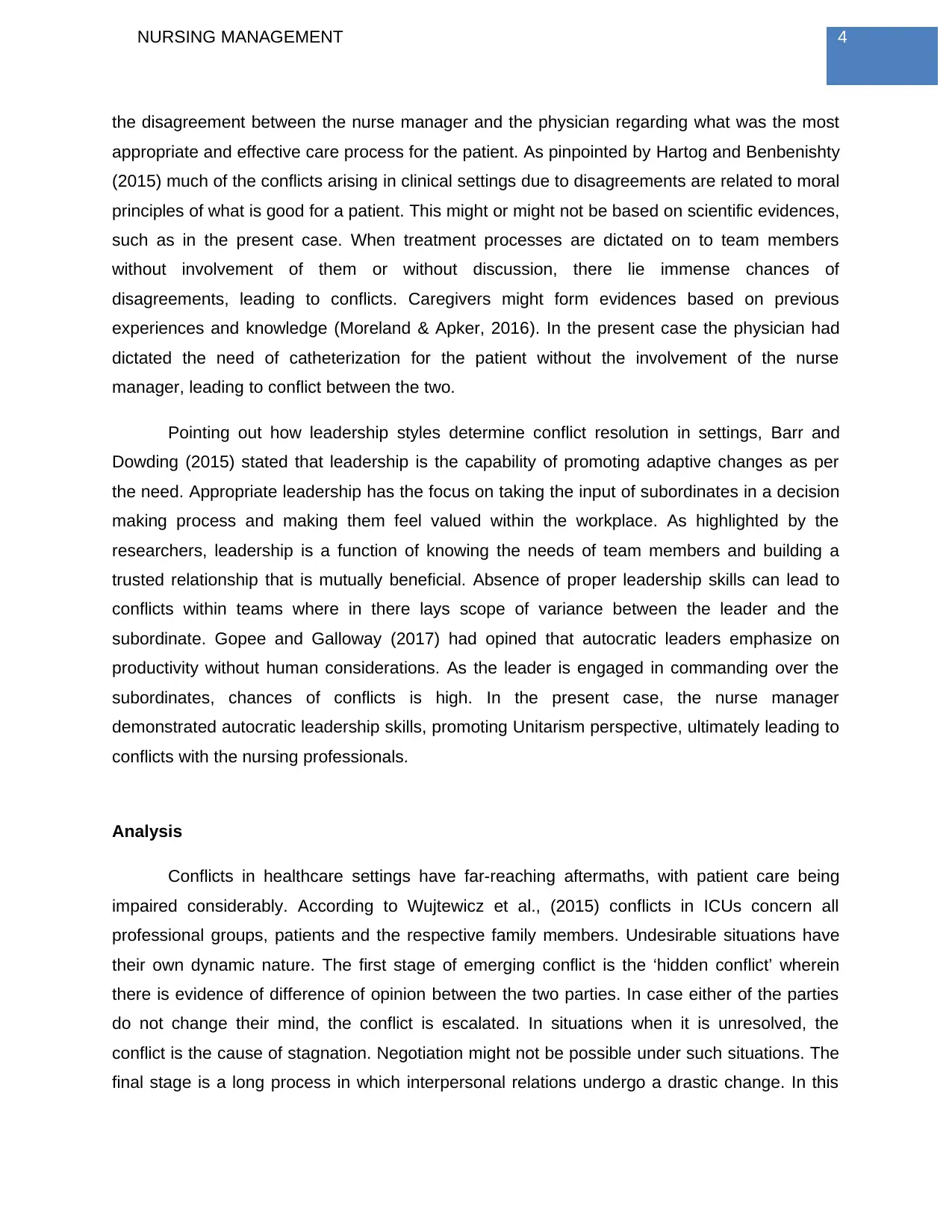
4NURSING MANAGEMENT
the disagreement between the nurse manager and the physician regarding what was the most
appropriate and effective care process for the patient. As pinpointed by Hartog and Benbenishty
(2015) much of the conflicts arising in clinical settings due to disagreements are related to moral
principles of what is good for a patient. This might or might not be based on scientific evidences,
such as in the present case. When treatment processes are dictated on to team members
without involvement of them or without discussion, there lie immense chances of
disagreements, leading to conflicts. Caregivers might form evidences based on previous
experiences and knowledge (Moreland & Apker, 2016). In the present case the physician had
dictated the need of catheterization for the patient without the involvement of the nurse
manager, leading to conflict between the two.
Pointing out how leadership styles determine conflict resolution in settings, Barr and
Dowding (2015) stated that leadership is the capability of promoting adaptive changes as per
the need. Appropriate leadership has the focus on taking the input of subordinates in a decision
making process and making them feel valued within the workplace. As highlighted by the
researchers, leadership is a function of knowing the needs of team members and building a
trusted relationship that is mutually beneficial. Absence of proper leadership skills can lead to
conflicts within teams where in there lays scope of variance between the leader and the
subordinate. Gopee and Galloway (2017) had opined that autocratic leaders emphasize on
productivity without human considerations. As the leader is engaged in commanding over the
subordinates, chances of conflicts is high. In the present case, the nurse manager
demonstrated autocratic leadership skills, promoting Unitarism perspective, ultimately leading to
conflicts with the nursing professionals.
Analysis
Conflicts in healthcare settings have far-reaching aftermaths, with patient care being
impaired considerably. According to Wujtewicz et al., (2015) conflicts in ICUs concern all
professional groups, patients and the respective family members. Undesirable situations have
their own dynamic nature. The first stage of emerging conflict is the ‘hidden conflict’ wherein
there is evidence of difference of opinion between the two parties. In case either of the parties
do not change their mind, the conflict is escalated. In situations when it is unresolved, the
conflict is the cause of stagnation. Negotiation might not be possible under such situations. The
final stage is a long process in which interpersonal relations undergo a drastic change. In this
the disagreement between the nurse manager and the physician regarding what was the most
appropriate and effective care process for the patient. As pinpointed by Hartog and Benbenishty
(2015) much of the conflicts arising in clinical settings due to disagreements are related to moral
principles of what is good for a patient. This might or might not be based on scientific evidences,
such as in the present case. When treatment processes are dictated on to team members
without involvement of them or without discussion, there lie immense chances of
disagreements, leading to conflicts. Caregivers might form evidences based on previous
experiences and knowledge (Moreland & Apker, 2016). In the present case the physician had
dictated the need of catheterization for the patient without the involvement of the nurse
manager, leading to conflict between the two.
Pointing out how leadership styles determine conflict resolution in settings, Barr and
Dowding (2015) stated that leadership is the capability of promoting adaptive changes as per
the need. Appropriate leadership has the focus on taking the input of subordinates in a decision
making process and making them feel valued within the workplace. As highlighted by the
researchers, leadership is a function of knowing the needs of team members and building a
trusted relationship that is mutually beneficial. Absence of proper leadership skills can lead to
conflicts within teams where in there lays scope of variance between the leader and the
subordinate. Gopee and Galloway (2017) had opined that autocratic leaders emphasize on
productivity without human considerations. As the leader is engaged in commanding over the
subordinates, chances of conflicts is high. In the present case, the nurse manager
demonstrated autocratic leadership skills, promoting Unitarism perspective, ultimately leading to
conflicts with the nursing professionals.
Analysis
Conflicts in healthcare settings have far-reaching aftermaths, with patient care being
impaired considerably. According to Wujtewicz et al., (2015) conflicts in ICUs concern all
professional groups, patients and the respective family members. Undesirable situations have
their own dynamic nature. The first stage of emerging conflict is the ‘hidden conflict’ wherein
there is evidence of difference of opinion between the two parties. In case either of the parties
do not change their mind, the conflict is escalated. In situations when it is unresolved, the
conflict is the cause of stagnation. Negotiation might not be possible under such situations. The
final stage is a long process in which interpersonal relations undergo a drastic change. In this
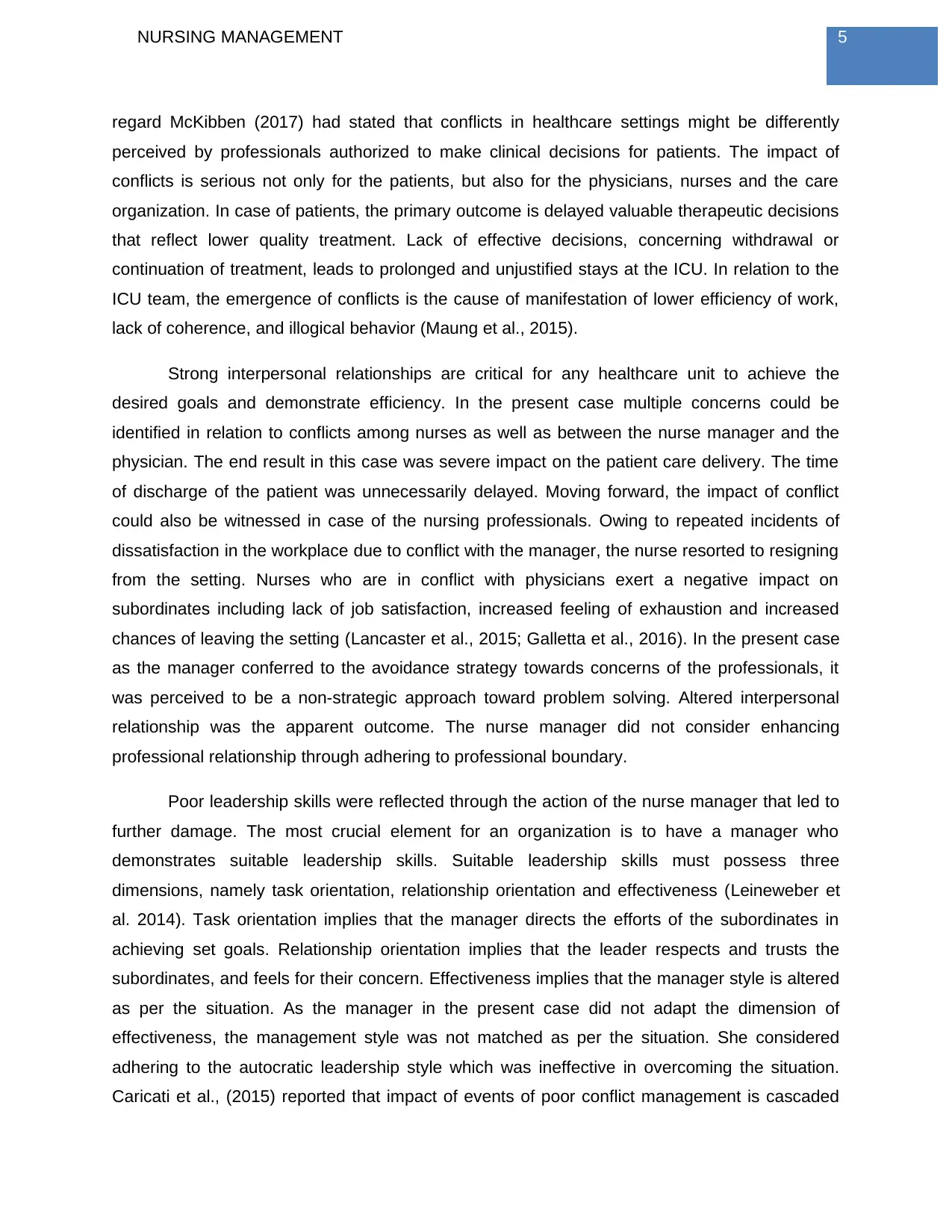
5NURSING MANAGEMENT
regard McKibben (2017) had stated that conflicts in healthcare settings might be differently
perceived by professionals authorized to make clinical decisions for patients. The impact of
conflicts is serious not only for the patients, but also for the physicians, nurses and the care
organization. In case of patients, the primary outcome is delayed valuable therapeutic decisions
that reflect lower quality treatment. Lack of effective decisions, concerning withdrawal or
continuation of treatment, leads to prolonged and unjustified stays at the ICU. In relation to the
ICU team, the emergence of conflicts is the cause of manifestation of lower efficiency of work,
lack of coherence, and illogical behavior (Maung et al., 2015).
Strong interpersonal relationships are critical for any healthcare unit to achieve the
desired goals and demonstrate efficiency. In the present case multiple concerns could be
identified in relation to conflicts among nurses as well as between the nurse manager and the
physician. The end result in this case was severe impact on the patient care delivery. The time
of discharge of the patient was unnecessarily delayed. Moving forward, the impact of conflict
could also be witnessed in case of the nursing professionals. Owing to repeated incidents of
dissatisfaction in the workplace due to conflict with the manager, the nurse resorted to resigning
from the setting. Nurses who are in conflict with physicians exert a negative impact on
subordinates including lack of job satisfaction, increased feeling of exhaustion and increased
chances of leaving the setting (Lancaster et al., 2015; Galletta et al., 2016). In the present case
as the manager conferred to the avoidance strategy towards concerns of the professionals, it
was perceived to be a non-strategic approach toward problem solving. Altered interpersonal
relationship was the apparent outcome. The nurse manager did not consider enhancing
professional relationship through adhering to professional boundary.
Poor leadership skills were reflected through the action of the nurse manager that led to
further damage. The most crucial element for an organization is to have a manager who
demonstrates suitable leadership skills. Suitable leadership skills must possess three
dimensions, namely task orientation, relationship orientation and effectiveness (Leineweber et
al. 2014). Task orientation implies that the manager directs the efforts of the subordinates in
achieving set goals. Relationship orientation implies that the leader respects and trusts the
subordinates, and feels for their concern. Effectiveness implies that the manager style is altered
as per the situation. As the manager in the present case did not adapt the dimension of
effectiveness, the management style was not matched as per the situation. She considered
adhering to the autocratic leadership style which was ineffective in overcoming the situation.
Caricati et al., (2015) reported that impact of events of poor conflict management is cascaded
regard McKibben (2017) had stated that conflicts in healthcare settings might be differently
perceived by professionals authorized to make clinical decisions for patients. The impact of
conflicts is serious not only for the patients, but also for the physicians, nurses and the care
organization. In case of patients, the primary outcome is delayed valuable therapeutic decisions
that reflect lower quality treatment. Lack of effective decisions, concerning withdrawal or
continuation of treatment, leads to prolonged and unjustified stays at the ICU. In relation to the
ICU team, the emergence of conflicts is the cause of manifestation of lower efficiency of work,
lack of coherence, and illogical behavior (Maung et al., 2015).
Strong interpersonal relationships are critical for any healthcare unit to achieve the
desired goals and demonstrate efficiency. In the present case multiple concerns could be
identified in relation to conflicts among nurses as well as between the nurse manager and the
physician. The end result in this case was severe impact on the patient care delivery. The time
of discharge of the patient was unnecessarily delayed. Moving forward, the impact of conflict
could also be witnessed in case of the nursing professionals. Owing to repeated incidents of
dissatisfaction in the workplace due to conflict with the manager, the nurse resorted to resigning
from the setting. Nurses who are in conflict with physicians exert a negative impact on
subordinates including lack of job satisfaction, increased feeling of exhaustion and increased
chances of leaving the setting (Lancaster et al., 2015; Galletta et al., 2016). In the present case
as the manager conferred to the avoidance strategy towards concerns of the professionals, it
was perceived to be a non-strategic approach toward problem solving. Altered interpersonal
relationship was the apparent outcome. The nurse manager did not consider enhancing
professional relationship through adhering to professional boundary.
Poor leadership skills were reflected through the action of the nurse manager that led to
further damage. The most crucial element for an organization is to have a manager who
demonstrates suitable leadership skills. Suitable leadership skills must possess three
dimensions, namely task orientation, relationship orientation and effectiveness (Leineweber et
al. 2014). Task orientation implies that the manager directs the efforts of the subordinates in
achieving set goals. Relationship orientation implies that the leader respects and trusts the
subordinates, and feels for their concern. Effectiveness implies that the manager style is altered
as per the situation. As the manager in the present case did not adapt the dimension of
effectiveness, the management style was not matched as per the situation. She considered
adhering to the autocratic leadership style which was ineffective in overcoming the situation.
Caricati et al., (2015) reported that impact of events of poor conflict management is cascaded
⊘ This is a preview!⊘
Do you want full access?
Subscribe today to unlock all pages.

Trusted by 1+ million students worldwide
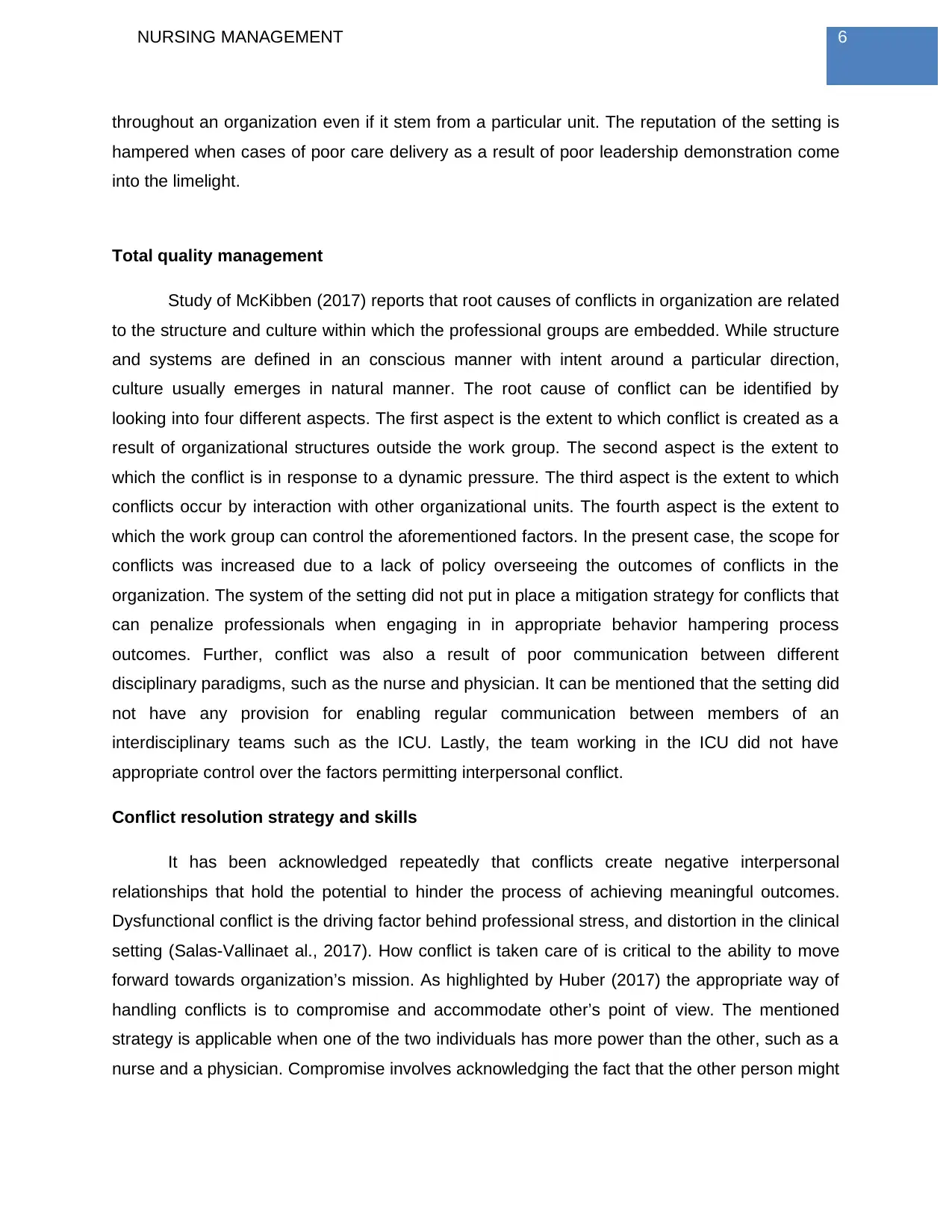
6NURSING MANAGEMENT
throughout an organization even if it stem from a particular unit. The reputation of the setting is
hampered when cases of poor care delivery as a result of poor leadership demonstration come
into the limelight.
Total quality management
Study of McKibben (2017) reports that root causes of conflicts in organization are related
to the structure and culture within which the professional groups are embedded. While structure
and systems are defined in an conscious manner with intent around a particular direction,
culture usually emerges in natural manner. The root cause of conflict can be identified by
looking into four different aspects. The first aspect is the extent to which conflict is created as a
result of organizational structures outside the work group. The second aspect is the extent to
which the conflict is in response to a dynamic pressure. The third aspect is the extent to which
conflicts occur by interaction with other organizational units. The fourth aspect is the extent to
which the work group can control the aforementioned factors. In the present case, the scope for
conflicts was increased due to a lack of policy overseeing the outcomes of conflicts in the
organization. The system of the setting did not put in place a mitigation strategy for conflicts that
can penalize professionals when engaging in in appropriate behavior hampering process
outcomes. Further, conflict was also a result of poor communication between different
disciplinary paradigms, such as the nurse and physician. It can be mentioned that the setting did
not have any provision for enabling regular communication between members of an
interdisciplinary teams such as the ICU. Lastly, the team working in the ICU did not have
appropriate control over the factors permitting interpersonal conflict.
Conflict resolution strategy and skills
It has been acknowledged repeatedly that conflicts create negative interpersonal
relationships that hold the potential to hinder the process of achieving meaningful outcomes.
Dysfunctional conflict is the driving factor behind professional stress, and distortion in the clinical
setting (Salas-Vallinaet al., 2017). How conflict is taken care of is critical to the ability to move
forward towards organization’s mission. As highlighted by Huber (2017) the appropriate way of
handling conflicts is to compromise and accommodate other’s point of view. The mentioned
strategy is applicable when one of the two individuals has more power than the other, such as a
nurse and a physician. Compromise involves acknowledging the fact that the other person might
throughout an organization even if it stem from a particular unit. The reputation of the setting is
hampered when cases of poor care delivery as a result of poor leadership demonstration come
into the limelight.
Total quality management
Study of McKibben (2017) reports that root causes of conflicts in organization are related
to the structure and culture within which the professional groups are embedded. While structure
and systems are defined in an conscious manner with intent around a particular direction,
culture usually emerges in natural manner. The root cause of conflict can be identified by
looking into four different aspects. The first aspect is the extent to which conflict is created as a
result of organizational structures outside the work group. The second aspect is the extent to
which the conflict is in response to a dynamic pressure. The third aspect is the extent to which
conflicts occur by interaction with other organizational units. The fourth aspect is the extent to
which the work group can control the aforementioned factors. In the present case, the scope for
conflicts was increased due to a lack of policy overseeing the outcomes of conflicts in the
organization. The system of the setting did not put in place a mitigation strategy for conflicts that
can penalize professionals when engaging in in appropriate behavior hampering process
outcomes. Further, conflict was also a result of poor communication between different
disciplinary paradigms, such as the nurse and physician. It can be mentioned that the setting did
not have any provision for enabling regular communication between members of an
interdisciplinary teams such as the ICU. Lastly, the team working in the ICU did not have
appropriate control over the factors permitting interpersonal conflict.
Conflict resolution strategy and skills
It has been acknowledged repeatedly that conflicts create negative interpersonal
relationships that hold the potential to hinder the process of achieving meaningful outcomes.
Dysfunctional conflict is the driving factor behind professional stress, and distortion in the clinical
setting (Salas-Vallinaet al., 2017). How conflict is taken care of is critical to the ability to move
forward towards organization’s mission. As highlighted by Huber (2017) the appropriate way of
handling conflicts is to compromise and accommodate other’s point of view. The mentioned
strategy is applicable when one of the two individuals has more power than the other, such as a
nurse and a physician. Compromise involves acknowledging the fact that the other person might
Paraphrase This Document
Need a fresh take? Get an instant paraphrase of this document with our AI Paraphraser
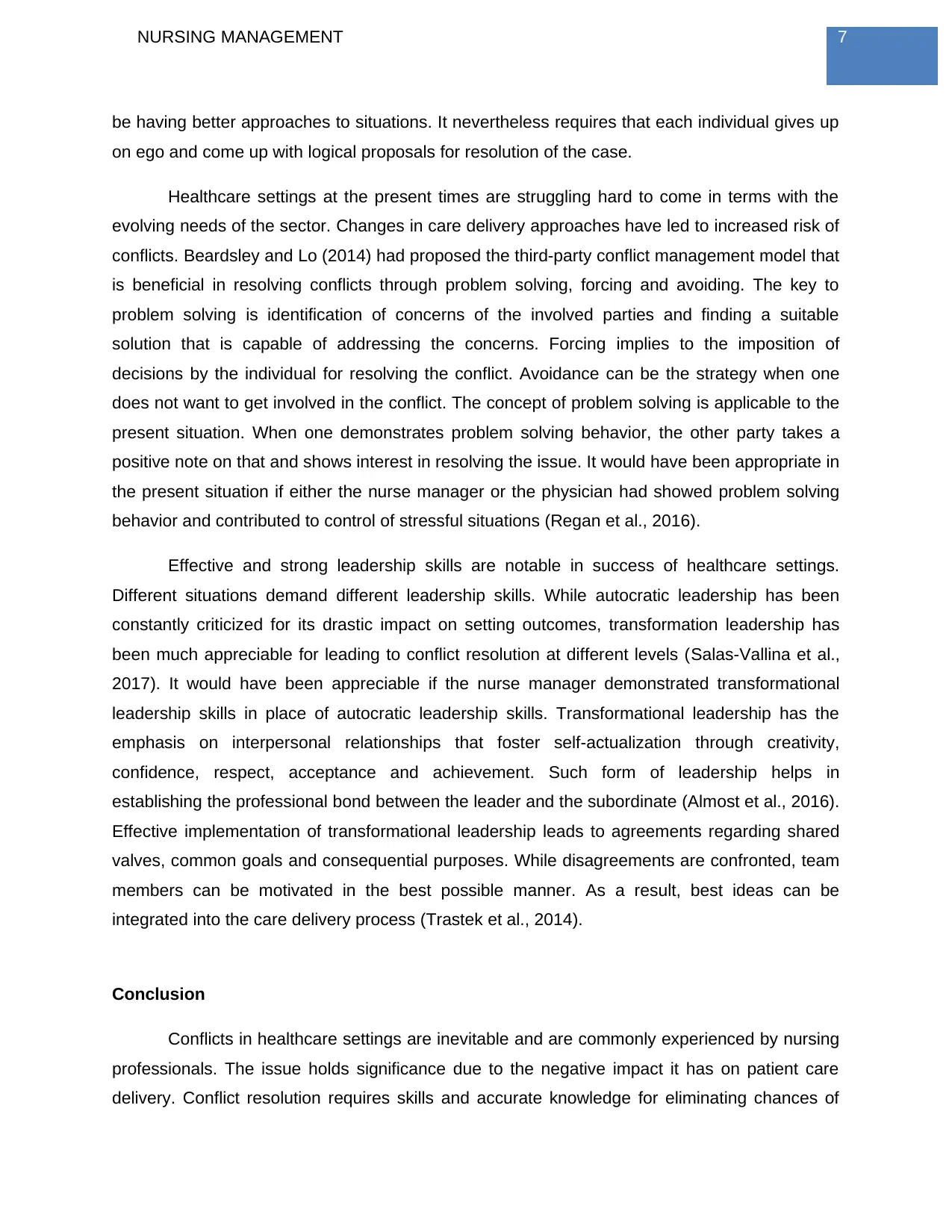
7NURSING MANAGEMENT
be having better approaches to situations. It nevertheless requires that each individual gives up
on ego and come up with logical proposals for resolution of the case.
Healthcare settings at the present times are struggling hard to come in terms with the
evolving needs of the sector. Changes in care delivery approaches have led to increased risk of
conflicts. Beardsley and Lo (2014) had proposed the third-party conflict management model that
is beneficial in resolving conflicts through problem solving, forcing and avoiding. The key to
problem solving is identification of concerns of the involved parties and finding a suitable
solution that is capable of addressing the concerns. Forcing implies to the imposition of
decisions by the individual for resolving the conflict. Avoidance can be the strategy when one
does not want to get involved in the conflict. The concept of problem solving is applicable to the
present situation. When one demonstrates problem solving behavior, the other party takes a
positive note on that and shows interest in resolving the issue. It would have been appropriate in
the present situation if either the nurse manager or the physician had showed problem solving
behavior and contributed to control of stressful situations (Regan et al., 2016).
Effective and strong leadership skills are notable in success of healthcare settings.
Different situations demand different leadership skills. While autocratic leadership has been
constantly criticized for its drastic impact on setting outcomes, transformation leadership has
been much appreciable for leading to conflict resolution at different levels (Salas-Vallina et al.,
2017). It would have been appreciable if the nurse manager demonstrated transformational
leadership skills in place of autocratic leadership skills. Transformational leadership has the
emphasis on interpersonal relationships that foster self-actualization through creativity,
confidence, respect, acceptance and achievement. Such form of leadership helps in
establishing the professional bond between the leader and the subordinate (Almost et al., 2016).
Effective implementation of transformational leadership leads to agreements regarding shared
valves, common goals and consequential purposes. While disagreements are confronted, team
members can be motivated in the best possible manner. As a result, best ideas can be
integrated into the care delivery process (Trastek et al., 2014).
Conclusion
Conflicts in healthcare settings are inevitable and are commonly experienced by nursing
professionals. The issue holds significance due to the negative impact it has on patient care
delivery. Conflict resolution requires skills and accurate knowledge for eliminating chances of
be having better approaches to situations. It nevertheless requires that each individual gives up
on ego and come up with logical proposals for resolution of the case.
Healthcare settings at the present times are struggling hard to come in terms with the
evolving needs of the sector. Changes in care delivery approaches have led to increased risk of
conflicts. Beardsley and Lo (2014) had proposed the third-party conflict management model that
is beneficial in resolving conflicts through problem solving, forcing and avoiding. The key to
problem solving is identification of concerns of the involved parties and finding a suitable
solution that is capable of addressing the concerns. Forcing implies to the imposition of
decisions by the individual for resolving the conflict. Avoidance can be the strategy when one
does not want to get involved in the conflict. The concept of problem solving is applicable to the
present situation. When one demonstrates problem solving behavior, the other party takes a
positive note on that and shows interest in resolving the issue. It would have been appropriate in
the present situation if either the nurse manager or the physician had showed problem solving
behavior and contributed to control of stressful situations (Regan et al., 2016).
Effective and strong leadership skills are notable in success of healthcare settings.
Different situations demand different leadership skills. While autocratic leadership has been
constantly criticized for its drastic impact on setting outcomes, transformation leadership has
been much appreciable for leading to conflict resolution at different levels (Salas-Vallina et al.,
2017). It would have been appreciable if the nurse manager demonstrated transformational
leadership skills in place of autocratic leadership skills. Transformational leadership has the
emphasis on interpersonal relationships that foster self-actualization through creativity,
confidence, respect, acceptance and achievement. Such form of leadership helps in
establishing the professional bond between the leader and the subordinate (Almost et al., 2016).
Effective implementation of transformational leadership leads to agreements regarding shared
valves, common goals and consequential purposes. While disagreements are confronted, team
members can be motivated in the best possible manner. As a result, best ideas can be
integrated into the care delivery process (Trastek et al., 2014).
Conclusion
Conflicts in healthcare settings are inevitable and are commonly experienced by nursing
professionals. The issue holds significance due to the negative impact it has on patient care
delivery. Conflict resolution requires skills and accurate knowledge for eliminating chances of
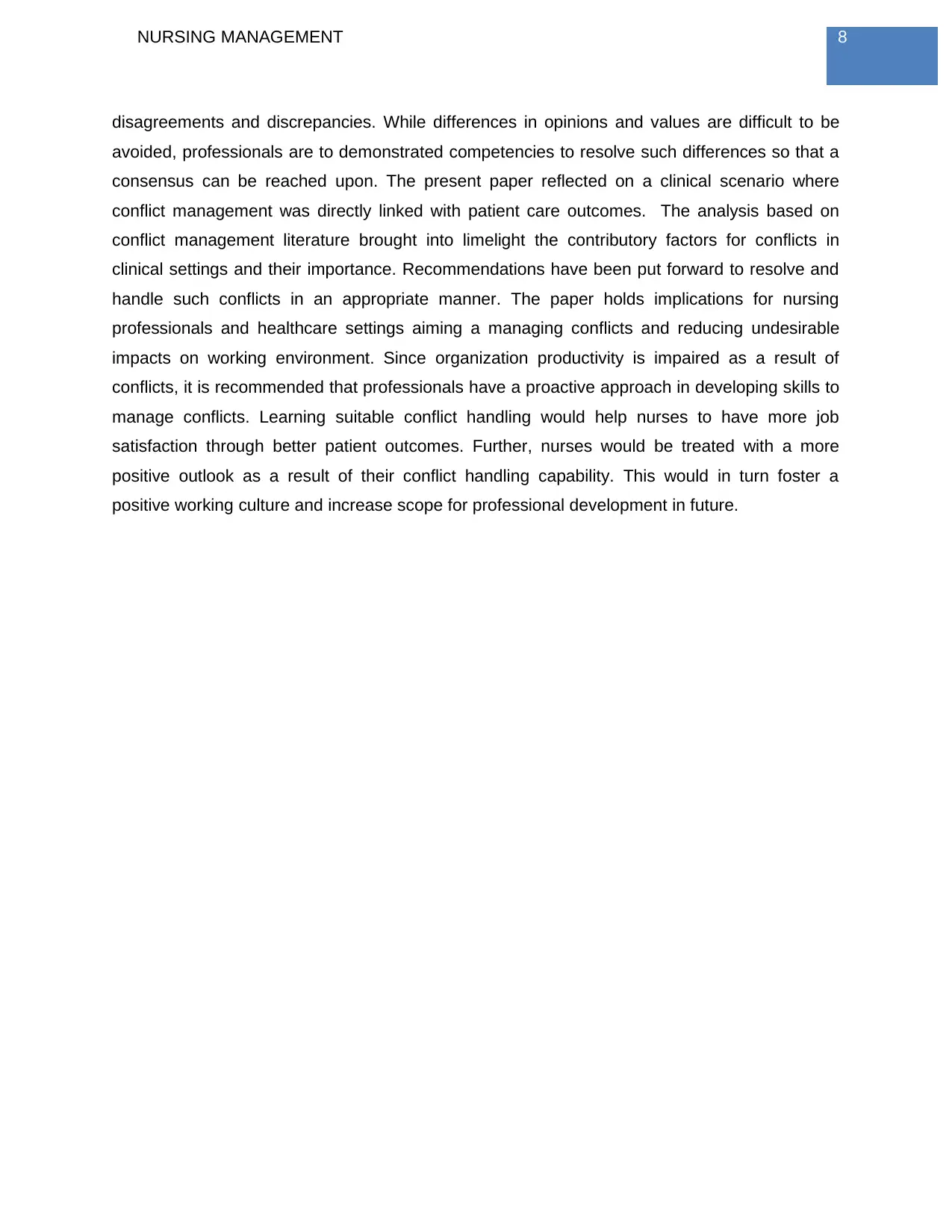
8NURSING MANAGEMENT
disagreements and discrepancies. While differences in opinions and values are difficult to be
avoided, professionals are to demonstrated competencies to resolve such differences so that a
consensus can be reached upon. The present paper reflected on a clinical scenario where
conflict management was directly linked with patient care outcomes. The analysis based on
conflict management literature brought into limelight the contributory factors for conflicts in
clinical settings and their importance. Recommendations have been put forward to resolve and
handle such conflicts in an appropriate manner. The paper holds implications for nursing
professionals and healthcare settings aiming a managing conflicts and reducing undesirable
impacts on working environment. Since organization productivity is impaired as a result of
conflicts, it is recommended that professionals have a proactive approach in developing skills to
manage conflicts. Learning suitable conflict handling would help nurses to have more job
satisfaction through better patient outcomes. Further, nurses would be treated with a more
positive outlook as a result of their conflict handling capability. This would in turn foster a
positive working culture and increase scope for professional development in future.
disagreements and discrepancies. While differences in opinions and values are difficult to be
avoided, professionals are to demonstrated competencies to resolve such differences so that a
consensus can be reached upon. The present paper reflected on a clinical scenario where
conflict management was directly linked with patient care outcomes. The analysis based on
conflict management literature brought into limelight the contributory factors for conflicts in
clinical settings and their importance. Recommendations have been put forward to resolve and
handle such conflicts in an appropriate manner. The paper holds implications for nursing
professionals and healthcare settings aiming a managing conflicts and reducing undesirable
impacts on working environment. Since organization productivity is impaired as a result of
conflicts, it is recommended that professionals have a proactive approach in developing skills to
manage conflicts. Learning suitable conflict handling would help nurses to have more job
satisfaction through better patient outcomes. Further, nurses would be treated with a more
positive outlook as a result of their conflict handling capability. This would in turn foster a
positive working culture and increase scope for professional development in future.
⊘ This is a preview!⊘
Do you want full access?
Subscribe today to unlock all pages.

Trusted by 1+ million students worldwide
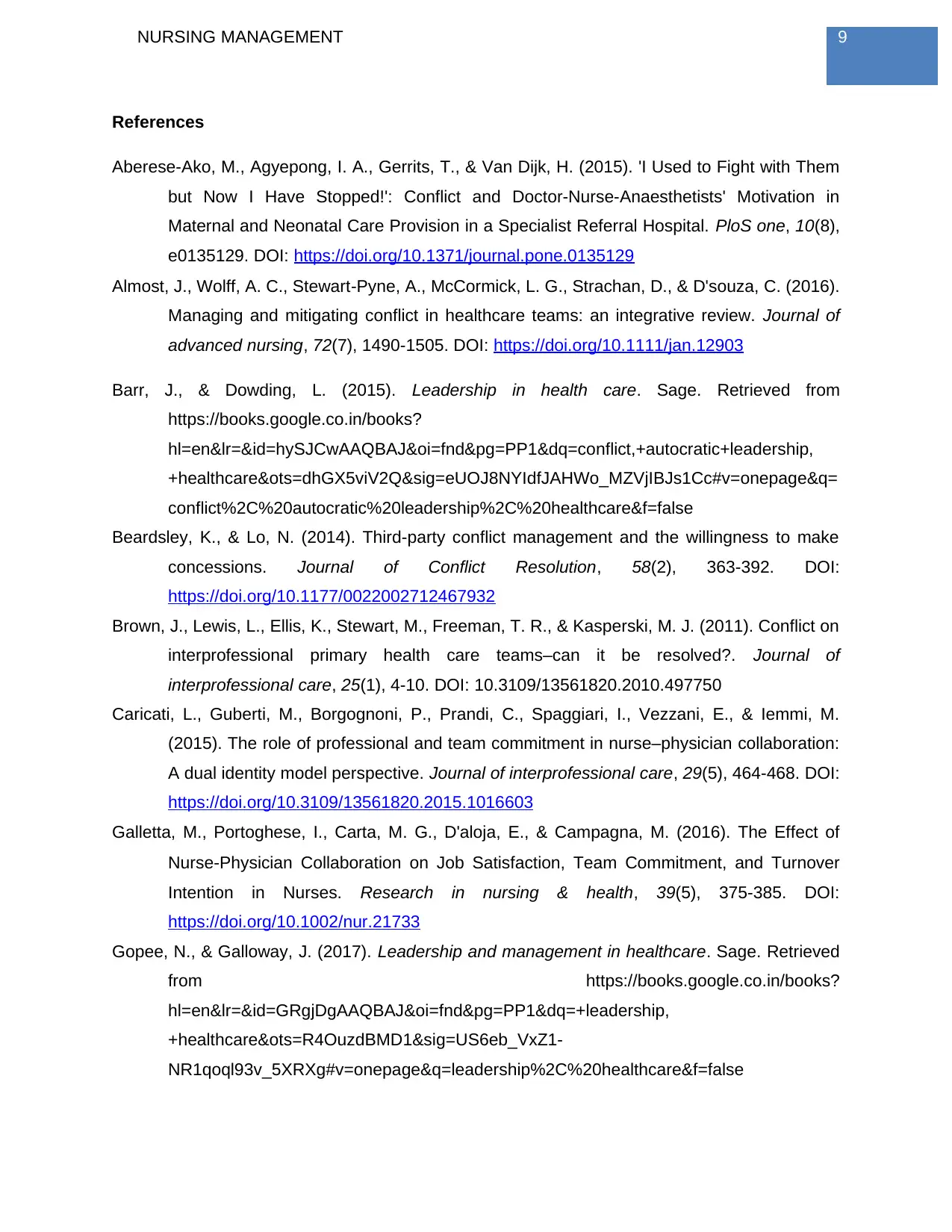
9NURSING MANAGEMENT
References
Aberese-Ako, M., Agyepong, I. A., Gerrits, T., & Van Dijk, H. (2015). 'I Used to Fight with Them
but Now I Have Stopped!': Conflict and Doctor-Nurse-Anaesthetists' Motivation in
Maternal and Neonatal Care Provision in a Specialist Referral Hospital. PloS one, 10(8),
e0135129. DOI: https://doi.org/10.1371/journal.pone.0135129
Almost, J., Wolff, A. C., Stewart‐Pyne, A., McCormick, L. G., Strachan, D., & D'souza, C. (2016).
Managing and mitigating conflict in healthcare teams: an integrative review. Journal of
advanced nursing, 72(7), 1490-1505. DOI: https://doi.org/10.1111/jan.12903
Barr, J., & Dowding, L. (2015). Leadership in health care. Sage. Retrieved from
https://books.google.co.in/books?
hl=en&lr=&id=hySJCwAAQBAJ&oi=fnd&pg=PP1&dq=conflict,+autocratic+leadership,
+healthcare&ots=dhGX5viV2Q&sig=eUOJ8NYIdfJAHWo_MZVjIBJs1Cc#v=onepage&q=
conflict%2C%20autocratic%20leadership%2C%20healthcare&f=false
Beardsley, K., & Lo, N. (2014). Third-party conflict management and the willingness to make
concessions. Journal of Conflict Resolution, 58(2), 363-392. DOI:
https://doi.org/10.1177/0022002712467932
Brown, J., Lewis, L., Ellis, K., Stewart, M., Freeman, T. R., & Kasperski, M. J. (2011). Conflict on
interprofessional primary health care teams–can it be resolved?. Journal of
interprofessional care, 25(1), 4-10. DOI: 10.3109/13561820.2010.497750
Caricati, L., Guberti, M., Borgognoni, P., Prandi, C., Spaggiari, I., Vezzani, E., & Iemmi, M.
(2015). The role of professional and team commitment in nurse–physician collaboration:
A dual identity model perspective. Journal of interprofessional care, 29(5), 464-468. DOI:
https://doi.org/10.3109/13561820.2015.1016603
Galletta, M., Portoghese, I., Carta, M. G., D'aloja, E., & Campagna, M. (2016). The Effect of
Nurse‐Physician Collaboration on Job Satisfaction, Team Commitment, and Turnover
Intention in Nurses. Research in nursing & health, 39(5), 375-385. DOI:
https://doi.org/10.1002/nur.21733
Gopee, N., & Galloway, J. (2017). Leadership and management in healthcare. Sage. Retrieved
from https://books.google.co.in/books?
hl=en&lr=&id=GRgjDgAAQBAJ&oi=fnd&pg=PP1&dq=+leadership,
+healthcare&ots=R4OuzdBMD1&sig=US6eb_VxZ1-
NR1qoql93v_5XRXg#v=onepage&q=leadership%2C%20healthcare&f=false
References
Aberese-Ako, M., Agyepong, I. A., Gerrits, T., & Van Dijk, H. (2015). 'I Used to Fight with Them
but Now I Have Stopped!': Conflict and Doctor-Nurse-Anaesthetists' Motivation in
Maternal and Neonatal Care Provision in a Specialist Referral Hospital. PloS one, 10(8),
e0135129. DOI: https://doi.org/10.1371/journal.pone.0135129
Almost, J., Wolff, A. C., Stewart‐Pyne, A., McCormick, L. G., Strachan, D., & D'souza, C. (2016).
Managing and mitigating conflict in healthcare teams: an integrative review. Journal of
advanced nursing, 72(7), 1490-1505. DOI: https://doi.org/10.1111/jan.12903
Barr, J., & Dowding, L. (2015). Leadership in health care. Sage. Retrieved from
https://books.google.co.in/books?
hl=en&lr=&id=hySJCwAAQBAJ&oi=fnd&pg=PP1&dq=conflict,+autocratic+leadership,
+healthcare&ots=dhGX5viV2Q&sig=eUOJ8NYIdfJAHWo_MZVjIBJs1Cc#v=onepage&q=
conflict%2C%20autocratic%20leadership%2C%20healthcare&f=false
Beardsley, K., & Lo, N. (2014). Third-party conflict management and the willingness to make
concessions. Journal of Conflict Resolution, 58(2), 363-392. DOI:
https://doi.org/10.1177/0022002712467932
Brown, J., Lewis, L., Ellis, K., Stewart, M., Freeman, T. R., & Kasperski, M. J. (2011). Conflict on
interprofessional primary health care teams–can it be resolved?. Journal of
interprofessional care, 25(1), 4-10. DOI: 10.3109/13561820.2010.497750
Caricati, L., Guberti, M., Borgognoni, P., Prandi, C., Spaggiari, I., Vezzani, E., & Iemmi, M.
(2015). The role of professional and team commitment in nurse–physician collaboration:
A dual identity model perspective. Journal of interprofessional care, 29(5), 464-468. DOI:
https://doi.org/10.3109/13561820.2015.1016603
Galletta, M., Portoghese, I., Carta, M. G., D'aloja, E., & Campagna, M. (2016). The Effect of
Nurse‐Physician Collaboration on Job Satisfaction, Team Commitment, and Turnover
Intention in Nurses. Research in nursing & health, 39(5), 375-385. DOI:
https://doi.org/10.1002/nur.21733
Gopee, N., & Galloway, J. (2017). Leadership and management in healthcare. Sage. Retrieved
from https://books.google.co.in/books?
hl=en&lr=&id=GRgjDgAAQBAJ&oi=fnd&pg=PP1&dq=+leadership,
+healthcare&ots=R4OuzdBMD1&sig=US6eb_VxZ1-
NR1qoql93v_5XRXg#v=onepage&q=leadership%2C%20healthcare&f=false
Paraphrase This Document
Need a fresh take? Get an instant paraphrase of this document with our AI Paraphraser
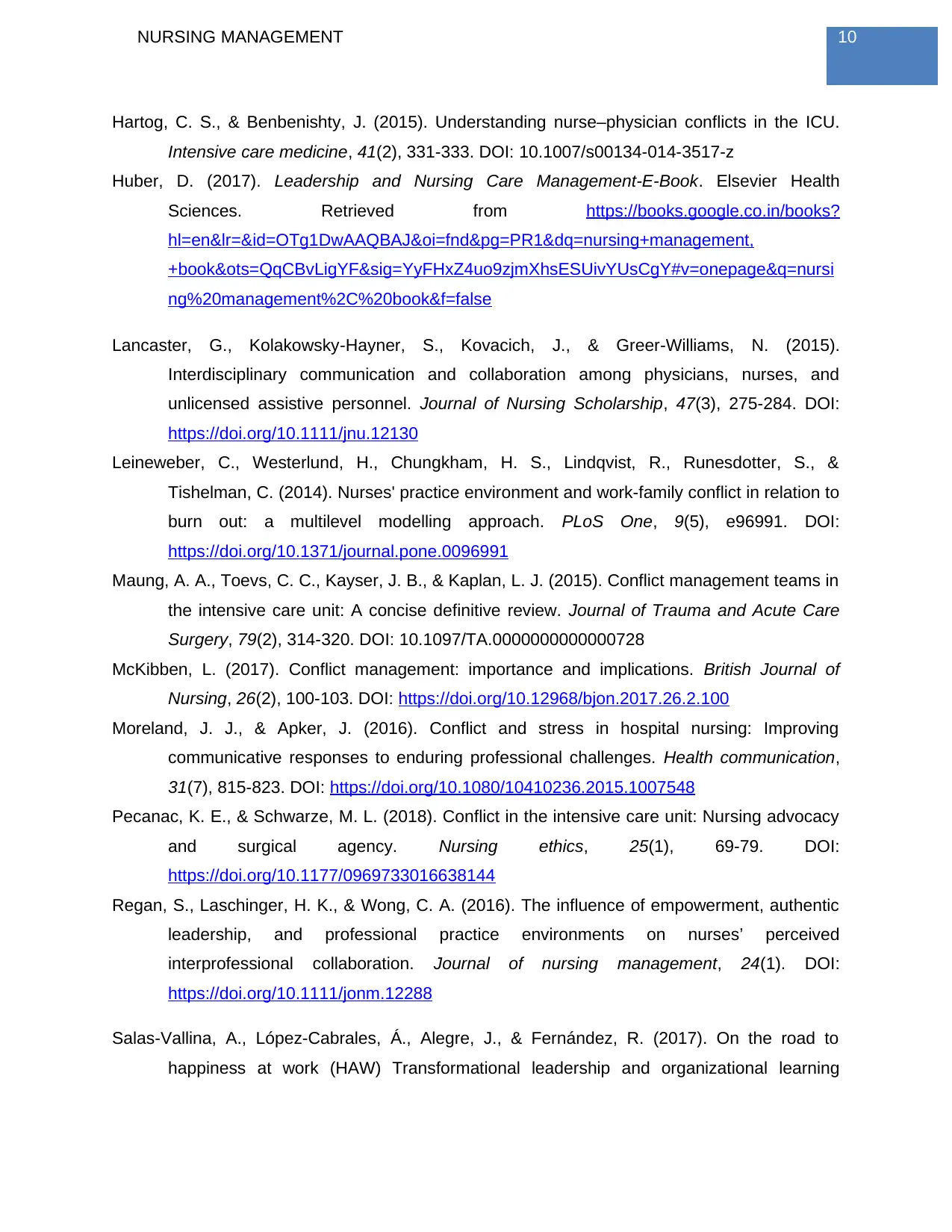
10NURSING MANAGEMENT
Hartog, C. S., & Benbenishty, J. (2015). Understanding nurse–physician conflicts in the ICU.
Intensive care medicine, 41(2), 331-333. DOI: 10.1007/s00134-014-3517-z
Huber, D. (2017). Leadership and Nursing Care Management-E-Book. Elsevier Health
Sciences. Retrieved from https://books.google.co.in/books?
hl=en&lr=&id=OTg1DwAAQBAJ&oi=fnd&pg=PR1&dq=nursing+management,
+book&ots=QqCBvLigYF&sig=YyFHxZ4uo9zjmXhsESUivYUsCgY#v=onepage&q=nursi
ng%20management%2C%20book&f=false
Lancaster, G., Kolakowsky‐Hayner, S., Kovacich, J., & Greer‐Williams, N. (2015).
Interdisciplinary communication and collaboration among physicians, nurses, and
unlicensed assistive personnel. Journal of Nursing Scholarship, 47(3), 275-284. DOI:
https://doi.org/10.1111/jnu.12130
Leineweber, C., Westerlund, H., Chungkham, H. S., Lindqvist, R., Runesdotter, S., &
Tishelman, C. (2014). Nurses' practice environment and work-family conflict in relation to
burn out: a multilevel modelling approach. PLoS One, 9(5), e96991. DOI:
https://doi.org/10.1371/journal.pone.0096991
Maung, A. A., Toevs, C. C., Kayser, J. B., & Kaplan, L. J. (2015). Conflict management teams in
the intensive care unit: A concise definitive review. Journal of Trauma and Acute Care
Surgery, 79(2), 314-320. DOI: 10.1097/TA.0000000000000728
McKibben, L. (2017). Conflict management: importance and implications. British Journal of
Nursing, 26(2), 100-103. DOI: https://doi.org/10.12968/bjon.2017.26.2.100
Moreland, J. J., & Apker, J. (2016). Conflict and stress in hospital nursing: Improving
communicative responses to enduring professional challenges. Health communication,
31(7), 815-823. DOI: https://doi.org/10.1080/10410236.2015.1007548
Pecanac, K. E., & Schwarze, M. L. (2018). Conflict in the intensive care unit: Nursing advocacy
and surgical agency. Nursing ethics, 25(1), 69-79. DOI:
https://doi.org/10.1177/0969733016638144
Regan, S., Laschinger, H. K., & Wong, C. A. (2016). The influence of empowerment, authentic
leadership, and professional practice environments on nurses’ perceived
interprofessional collaboration. Journal of nursing management, 24(1). DOI:
https://doi.org/10.1111/jonm.12288
Salas-Vallina, A., López-Cabrales, Á., Alegre, J., & Fernández, R. (2017). On the road to
happiness at work (HAW) Transformational leadership and organizational learning
Hartog, C. S., & Benbenishty, J. (2015). Understanding nurse–physician conflicts in the ICU.
Intensive care medicine, 41(2), 331-333. DOI: 10.1007/s00134-014-3517-z
Huber, D. (2017). Leadership and Nursing Care Management-E-Book. Elsevier Health
Sciences. Retrieved from https://books.google.co.in/books?
hl=en&lr=&id=OTg1DwAAQBAJ&oi=fnd&pg=PR1&dq=nursing+management,
+book&ots=QqCBvLigYF&sig=YyFHxZ4uo9zjmXhsESUivYUsCgY#v=onepage&q=nursi
ng%20management%2C%20book&f=false
Lancaster, G., Kolakowsky‐Hayner, S., Kovacich, J., & Greer‐Williams, N. (2015).
Interdisciplinary communication and collaboration among physicians, nurses, and
unlicensed assistive personnel. Journal of Nursing Scholarship, 47(3), 275-284. DOI:
https://doi.org/10.1111/jnu.12130
Leineweber, C., Westerlund, H., Chungkham, H. S., Lindqvist, R., Runesdotter, S., &
Tishelman, C. (2014). Nurses' practice environment and work-family conflict in relation to
burn out: a multilevel modelling approach. PLoS One, 9(5), e96991. DOI:
https://doi.org/10.1371/journal.pone.0096991
Maung, A. A., Toevs, C. C., Kayser, J. B., & Kaplan, L. J. (2015). Conflict management teams in
the intensive care unit: A concise definitive review. Journal of Trauma and Acute Care
Surgery, 79(2), 314-320. DOI: 10.1097/TA.0000000000000728
McKibben, L. (2017). Conflict management: importance and implications. British Journal of
Nursing, 26(2), 100-103. DOI: https://doi.org/10.12968/bjon.2017.26.2.100
Moreland, J. J., & Apker, J. (2016). Conflict and stress in hospital nursing: Improving
communicative responses to enduring professional challenges. Health communication,
31(7), 815-823. DOI: https://doi.org/10.1080/10410236.2015.1007548
Pecanac, K. E., & Schwarze, M. L. (2018). Conflict in the intensive care unit: Nursing advocacy
and surgical agency. Nursing ethics, 25(1), 69-79. DOI:
https://doi.org/10.1177/0969733016638144
Regan, S., Laschinger, H. K., & Wong, C. A. (2016). The influence of empowerment, authentic
leadership, and professional practice environments on nurses’ perceived
interprofessional collaboration. Journal of nursing management, 24(1). DOI:
https://doi.org/10.1111/jonm.12288
Salas-Vallina, A., López-Cabrales, Á., Alegre, J., & Fernández, R. (2017). On the road to
happiness at work (HAW) Transformational leadership and organizational learning
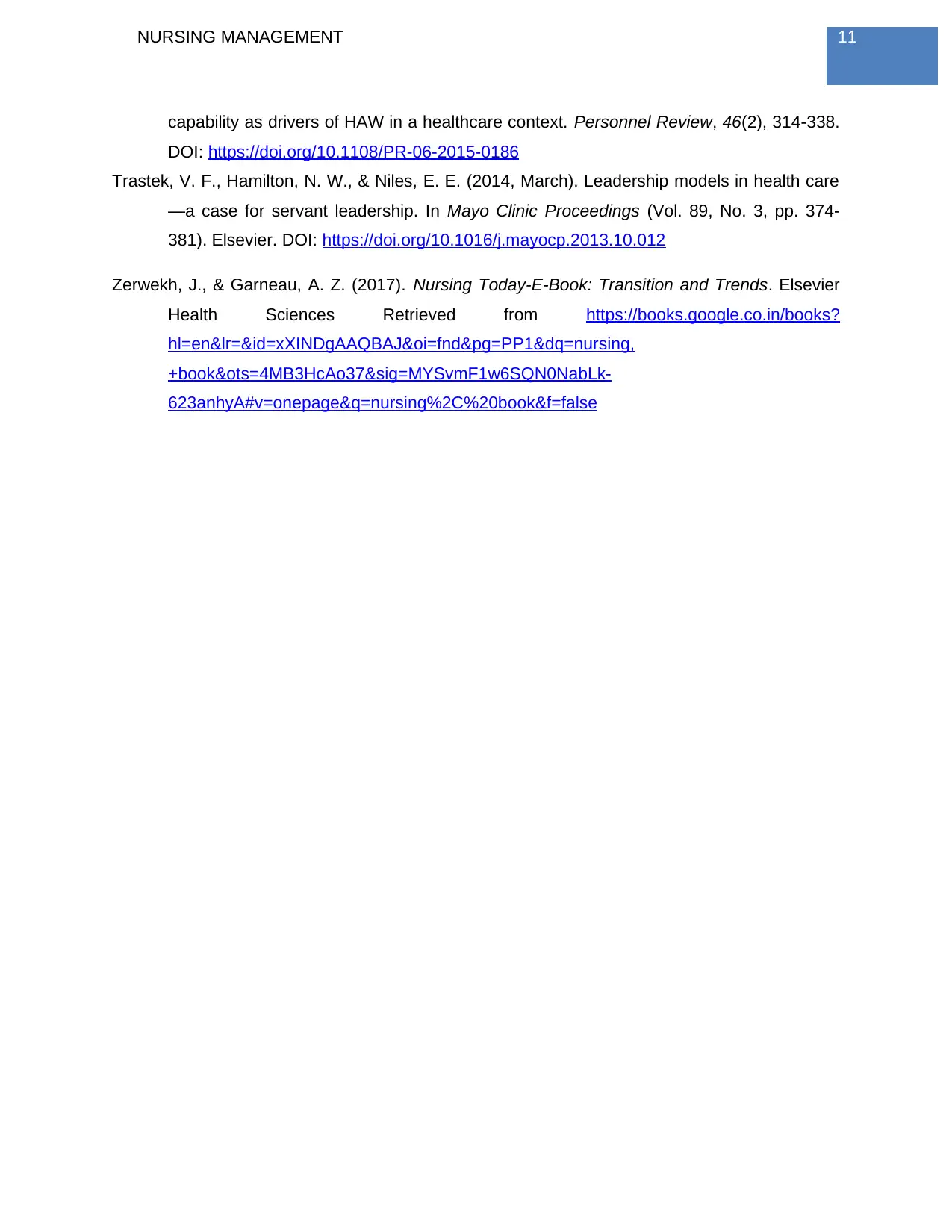
11NURSING MANAGEMENT
capability as drivers of HAW in a healthcare context. Personnel Review, 46(2), 314-338.
DOI: https://doi.org/10.1108/PR-06-2015-0186
Trastek, V. F., Hamilton, N. W., & Niles, E. E. (2014, March). Leadership models in health care
—a case for servant leadership. In Mayo Clinic Proceedings (Vol. 89, No. 3, pp. 374-
381). Elsevier. DOI: https://doi.org/10.1016/j.mayocp.2013.10.012
Zerwekh, J., & Garneau, A. Z. (2017). Nursing Today-E-Book: Transition and Trends. Elsevier
Health Sciences Retrieved from https://books.google.co.in/books?
hl=en&lr=&id=xXINDgAAQBAJ&oi=fnd&pg=PP1&dq=nursing,
+book&ots=4MB3HcAo37&sig=MYSvmF1w6SQN0NabLk-
623anhyA#v=onepage&q=nursing%2C%20book&f=false
capability as drivers of HAW in a healthcare context. Personnel Review, 46(2), 314-338.
DOI: https://doi.org/10.1108/PR-06-2015-0186
Trastek, V. F., Hamilton, N. W., & Niles, E. E. (2014, March). Leadership models in health care
—a case for servant leadership. In Mayo Clinic Proceedings (Vol. 89, No. 3, pp. 374-
381). Elsevier. DOI: https://doi.org/10.1016/j.mayocp.2013.10.012
Zerwekh, J., & Garneau, A. Z. (2017). Nursing Today-E-Book: Transition and Trends. Elsevier
Health Sciences Retrieved from https://books.google.co.in/books?
hl=en&lr=&id=xXINDgAAQBAJ&oi=fnd&pg=PP1&dq=nursing,
+book&ots=4MB3HcAo37&sig=MYSvmF1w6SQN0NabLk-
623anhyA#v=onepage&q=nursing%2C%20book&f=false
⊘ This is a preview!⊘
Do you want full access?
Subscribe today to unlock all pages.

Trusted by 1+ million students worldwide
1 out of 12
Related Documents
Your All-in-One AI-Powered Toolkit for Academic Success.
+13062052269
info@desklib.com
Available 24*7 on WhatsApp / Email
![[object Object]](/_next/static/media/star-bottom.7253800d.svg)
Unlock your academic potential
Copyright © 2020–2025 A2Z Services. All Rights Reserved. Developed and managed by ZUCOL.





